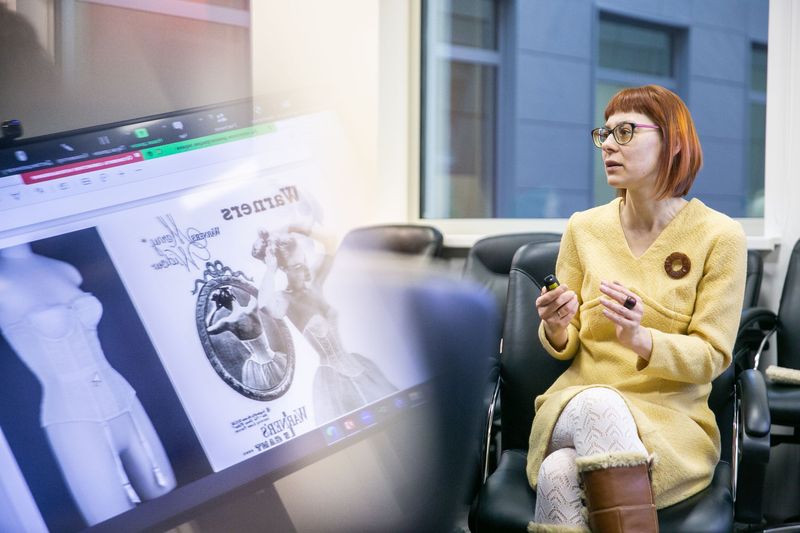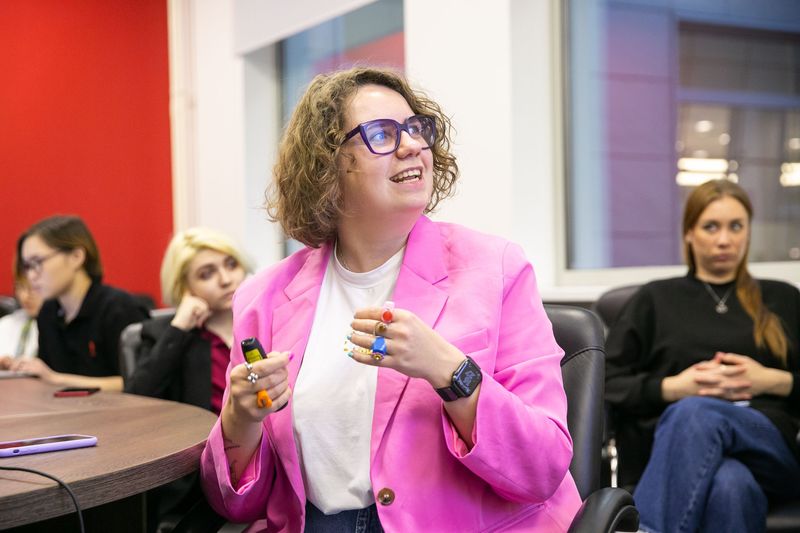‘An Avatar Is an Image of a Posthuman’: Mediacosm Held at HSE University

On February 16, the sixth Mediacosm conference was held. The event traditionally dedicated to discursive and non-discursive ways of presenting the cosmos through media, fashion and music was organised by the HSE Faculty of Creative Industries.
Researchers studying the concept and materialisation of the cosmos in culture through different languages and practices were among the conference participants.

Asya Aladzhalova, doctoral student at the HSE Doctoral School of Art and Design, presented a report on the topic ‘A 60s Suit as an Extension of the Body: The Difference between a Spacesuit and a Crimplene’. Her presentation was based on the study of the relation between the human body and clothing in both space exploration and fashion. She highlighted the fact that before travelling into Earth orbit in the 1960s, astronauts underwent comprehensive training.
‘They trained using the same suits and experienced the same atmospheric stresses that they would later encounter in real space conditions. Such suits were difficult to wear—they weighed about 10 kg, had many layers of different fabrics, and it was difficult to move in them,’ she says . She also compared haute couture women’s outfits of the same era with spacesuits.
‘When we talk about space collections in fashion or about images of astronauts in spacesuits in the 1960s, we often focus on the visual image. And what do we see? We see smiling people in beautiful shiny new outfits. And what did they really experience? What did their bodies experience while wearing those fashionable spacesuits? That's the question,’ says the researcher. She compared spacesuits with women's corsets of the time, which also tightened the body and restricted movement.

Nina Veresova, doctoral student at the HSE Doctoral School of Art and Design, also mentioned corsets while speaking about her study on the topic ‘The Connection with Home: The Role of Textiles in Space.’ She believes that ensuring a tight fit of spacesuit is important. Such outfits can be fixed like a corset: the trousers and shoes can be laced to ensure a better fit and to adjust them, which is quite important, since these items are not made of stretchy material.
‘Spaceships have a lot of textile fabric elements that are fixed like a corset,’ she explains. She also said that since all astronauts should be able to properly repair their suits in space, they master sewing and other skills. ‘If a spacesuit cannot be repaired, then it can be disassembled for parts and used in other, new spacesuits. But it is economically important to make it durable,’ she says.

Oksana Pertel, doctoral student at the HSE Doctoral School of Art and Design, presented the project ‘The Avatar as an Image of a Digital Posthuman Conqueror of the Metaverses and the Cosmos.’ In the modern world, people design avatar images for various functions, including virtual fashion. People should not distance themselves from new technologies. To some extent, avatars can be considered an extension of human capabilities and the transfer of new meanings and syntheses.
‘I suggest considering avatars not as simulacra or phantoms,’ she says. ‘We spend a lot of time online, and avatars now represent people on social media. There are also avatars who live “independent” lives: they sell things, earn money, represent marketing campaigns. And we have to reckon with them. I proceed from the idea that an avatar is an image of a posthuman.’
For more information about the Mediacosm conference, please see this HSE Daily news item (in Russian).
The Mediacosm conference is part of the project ‘Space in Media Culture: Practices of Imagination and Representation’ of the HSE Faculty of Creative Industries. The project is more relevant than ever thanks to the return of the topic of space exploration in the public agenda, increasing public interest in astronomical discoveries and the achievements of cosmonautics, the development of scientific communication and the popularisation of scientific knowledge in this field. The project, which includes several types of activities (research and educational), considers space from a socio-humanitarian perspective and focuses on the research into astroculture, primarily in terms of its media dimension.
See also:
HSE, University of Delhi, and Geoscan Launch Space Research Project
HSE University and the University of Delhi (India), in partnership with Geoscan (a portfolio company of the Innopraktika non-state development institute), have agreed to establish an international scientific mirror laboratory on data storage, processing, and transmission in space systems. The agreement was signed on January 15, 2025, during a visit to India by an HSE University delegation led by Rector Nikita Anisimov.
Fashion for Strong Women: Emancifashion Exhibition Takes Place at HSE University
In early November, the Emancifashion exhibition, dedicated to the representation of women in art and fashion, took place at HSE University in Maly Trekhsvyatitelsky Pereulok. The event, organised by first-year students from the HSE Media Communications programme, featured works created by students from the Fashion Design programme of the HSE Art and Design School.
HSE Art and Design School in St Petersburg Launches Fashion Design Track
Starting from 2024, applicants to the HSE Art and Design School in St Petersburg will be able to choose a new track in Fashion Design—something unique to the city’s fashion industry. Students of the new track will study according to a special programme developed by the HSE Art and Design School. The track has already been successfully tested on the Moscow campus and has shown impressive results, judging by the careers of its graduates.
‘Our Graduates’ Task Is To Show Themselves as Designers’
In mid-July, HSE Art and Design School hosted the graduate fashion show for the Bachelor’s and Master’s programmes in the Fashion Design and Fashion Brand Creation pathways. Guests saw 20 collections from young designers, with each of them reflecting on an exciting topic, while creating unusual images from a variety of materials.
'In Outer Space, Encounters between Humans and Non-humans Could be in a Variety of Languages'
On November 5, the Museum of Cosmonautics in Moscow hosted an HSE-organised event entitled 'Cosmic Bodies: A Philosophical and Musical Party for Cyborgs'. The speakers and the audience reflected on popular-culture depictions of humans as they explore outer space.
Scientists Learn to Better Predict Space Weather
An international team of astrophysicists has been studying the formation of strong electrostatic waves, ion holes, in the Earth's magnetotail and assessing their impact on space weather. They found that ion holes propagate oblique to the local magnetic field. The study's findings can contribute to a better understanding of processes in the Earth's magnetotail which affect space weather in the near-Earth plasma environment and the polar region. The paper is published in Geophysical Research Letters.
HSE University Launches Study at GES-2 Cultural Centre
The MendiT Research Lab, based at the HSE University Doctoral School of Arts and Design, will become a resident of the GES-2 Cultural Centre for a month from June 5th. The researchers will introduce members of the urban community to the lab and explore the practices of mending clothes together with them. Some of the lab participants told the HSE News Service what it's like to be searching for a method and object of research.
HSE University Participates in Satellite Navigation Monitoring Project
A team of HSE students is taking part in the development of a Russian satellite automatic identification system (AIS) to monitor sea navigation. The aim of the project is to track the locations of vessels and adjust their routes, including in the Arctic along the Northern Sea Route.
Projects by HSE Art and Design School Students at New UNIQLO Store
The HSE Art and Design School continues to collaborate with the UNIQLO clothing brand. Fashion majors will showcase their upcycle projects at UNIQLO MOSCOW, Evropeisky mall—the brand’s biggest store in Russia and Europe.
Fashion, As We Knew It, Is Disappearing
Fashion Theory journal Editor-in-Chief Liudmila Alyabieva explains how the pandemic has changed our wardrobe as well as expectations of the fashion industry — and ourselves.


